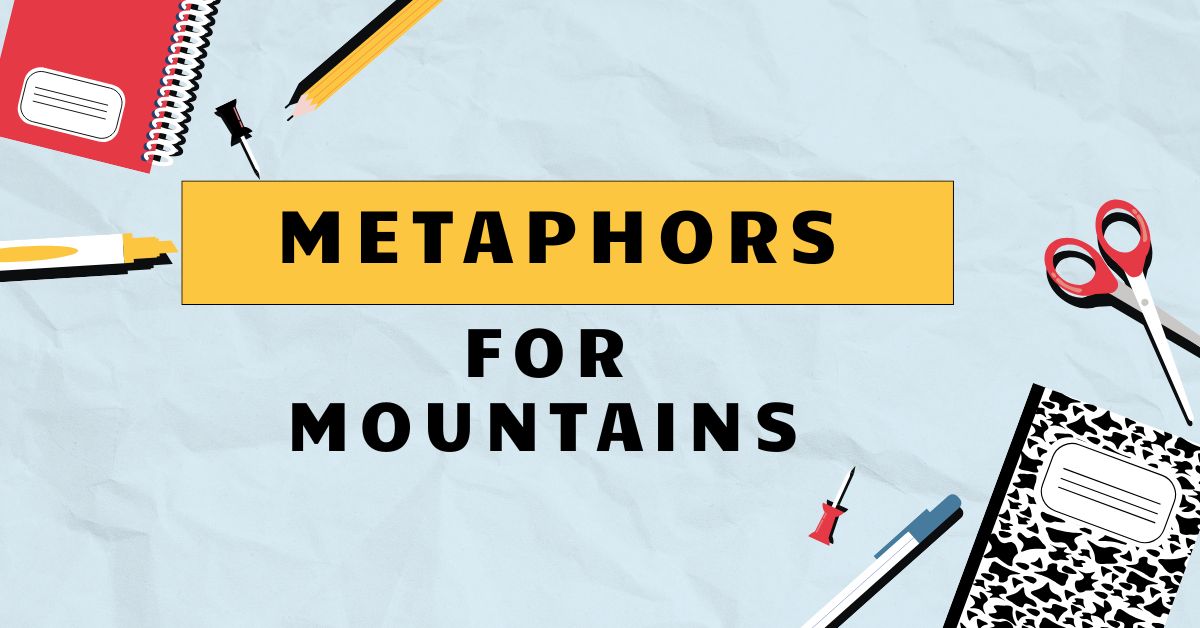37 Mountains of Meaning: Exploring Metaphors for Mountains
Metaphors are powerful tools that enrich our language, allowing us to understand abstract concepts by comparing them to more concrete ones. Understanding metaphors, especially those used to describe grand and imposing features like mountains, enhances our comprehension of both language and the world around us.
This article delves into the world of metaphors for mountains, exploring their various forms, meanings, and applications in English. This guide benefits students, writers, and anyone keen on mastering the art of figurative language, providing a structured approach to identifying, analyzing, and using mountain metaphors effectively.
By exploring the rich landscape of mountain metaphors, we can gain a deeper appreciation for the nuances of language and the creative ways in which we express complex ideas. This article will provide a thorough exploration of metaphors related to mountains, including their structural elements, various types, and practical examples.
Table of Contents
- Introduction
- Definition of Metaphor and Its Application to Mountains
- Structural Breakdown of Mountain Metaphors
- Types and Categories of Mountain Metaphors
- Examples of Mountain Metaphors
- Usage Rules for Mountain Metaphors
- Common Mistakes When Using Mountain Metaphors
- Practice Exercises
- Advanced Topics in Mountain Metaphors
- Frequently Asked Questions
- Conclusion
Definition of Metaphor and Its Application to Mountains
Ametaphoris a figure of speech that directly compares two unrelated things without using “like” or “as.” It asserts that one thing *is* another, creating a vivid and often insightful comparison. The purpose is to transfer qualities from one concept (the source) to another (the target), enhancing understanding and adding depth to language.
Metaphors are not meant to be taken literally; their power lies in their ability to evoke imagery and suggest deeper meanings.
When applied to mountains, metaphors can tap into the various characteristics associated with these geological formations: their size, height, permanence, and the challenges they present. Mountains can represent obstacles, goals, sources of inspiration, or symbols of strength.
The specific meaning depends on the context and the qualities the speaker or writer wishes to emphasize. The use of mountain metaphors allows for a richer, more evocative description than a simple, literal statement could provide.
For instance, stating “The project was a mountain to climb” conveys not only the difficulty of the project but also the sense of challenge, perseverance, and potential reward associated with scaling a mountain. The metaphor invites the reader to visualize the task as a monumental undertaking requiring significant effort and determination.
Structural Breakdown of Mountain Metaphors
Mountain metaphors, like all metaphors, consist of two primary components: thetenorand thevehicle. The tenor is the subject being described, while the vehicle is the mountain itself, which lends its attributes to the tenor.
The effectiveness of a mountain metaphor hinges on the clear connection between the mountain’s characteristics and the subject being described.
Consider the metaphor, “His debt was a mountain looming over him.” Here, the tenor is “his debt,” and the vehicle is “a mountain.” The metaphor works because mountains are associated with being large, imposing, and difficult to overcome, qualities that effectively convey the overwhelming nature of the debt. The ground is the shared characteristic between the debt and the mountain, which in this case is the sense of being an insurmountable burden.
A successful mountain metaphor also relies on thecontextin which it is used. The surrounding words and phrases should support the metaphorical meaning and prevent misinterpretation.
If the context is unclear, the metaphor may fall flat or create confusion. For example, if someone says, “She moved mountains to help him,” the context should indicate that “moving mountains” refers to overcoming significant obstacles, rather than a literal act of physical displacement.
The structure can be further analyzed by examining the specificattributesof mountains that are being emphasized. Are they being used to represent height, difficulty, stability, or something else?
Identifying these attributes helps to fully understand the intended meaning of the metaphor. A mountain’s peak might symbolize achievement, its base might represent a foundation, and its rugged terrain could signify challenges.
Types and Categories of Mountain Metaphors
Mountain metaphors can be categorized based on the specific qualities of mountains they emphasize and the concepts they are used to represent. Here are several common categories:
Mountains as Challenges and Obstacles
This is perhaps the most common type of mountain metaphor. Mountains, due to their imposing size and the effort required to climb them, are frequently used to represent difficult tasks, problems, or challenges that need to be overcome.
These metaphors emphasize the struggle, perseverance, and eventual triumph associated with overcoming obstacles.
Mountains as Symbols of Stability and Permanence
Mountains, being ancient and enduring geological formations, can also symbolize stability, permanence, and strength. These metaphors highlight the steadfastness and unyielding nature of mountains, suggesting resilience and reliability.
They are often used to describe institutions, relationships, or values that are meant to last.
Mountains as Goals, Achievements, and Aspirations
The act of climbing a mountain and reaching its peak can symbolize achieving a goal or fulfilling an aspiration. Mountain metaphors in this category emphasize the ambition, hard work, and sense of accomplishment associated with reaching the summit.
They often represent personal growth, career success, or the realization of a long-held dream.
Mountains as Sources of Awe and Inspiration
Mountains, with their majestic beauty and grandeur, can inspire awe and wonder. These metaphors highlight the emotional impact of mountains, suggesting a sense of reverence, inspiration, and spiritual connection.
They are often used to describe art, nature, or experiences that evoke profound feelings.
Mountains as Barriers and Isolation
While mountains can symbolize challenges to overcome, they can also represent barriers that separate people or things. These metaphors emphasize the isolating effect of mountains, suggesting division, remoteness, and a lack of connection.
They are often used to describe geographical or social divides that are difficult to bridge.
Examples of Mountain Metaphors
Here are several examples of mountain metaphors, organized by category, to illustrate their diverse applications.
Examples of Mountains as Challenges
Mountains are often used as metaphors to represent the challenges and obstacles in life. The following table provides examples of how mountains can symbolize the difficulties one must overcome.
| Metaphor | Explanation |
|---|---|
| The sheer volume of paperwork felt like climbing a mountain. | The large amount of paperwork is compared to the arduous task of climbing a mountain, suggesting it is overwhelming and requires significant effort. |
| Getting through this project will be like scaling Mount Everest. | This implies that the project is extremely challenging and will require immense effort and determination. |
| Her financial problems were a mountain she couldn’t seem to climb. | The financial problems are portrayed as a massive obstacle that she is struggling to overcome. |
| The bureaucracy was a mountain range that blocked their progress. | The bureaucratic processes are seen as a series of significant obstacles hindering advancement. |
| His lack of experience was a mountain in his path to success. | The lack of experience is depicted as a major barrier preventing him from achieving his goals. |
| The language barrier was a mountain between them. | The difficulty in communication is likened to a substantial obstacle separating them. |
| The legal battle felt like a mountain of paperwork. | The extensive and complex legal paperwork is compared to a mountain, emphasizing its overwhelming nature. |
| Overcoming her fear of public speaking was her personal Mount Everest. | Her fear is portrayed as a monumental challenge, akin to climbing the world’s highest peak. |
| The mountain of debt threatened to bury them alive. | The overwhelming debt is depicted as a life-threatening burden. |
| The mountain of evidence against him was insurmountable. | The overwhelming amount of evidence makes his defense seem impossible. |
| The challenges ahead felt like a never-ending mountain range. | The continuous series of challenges is compared to an endless chain of mountains. |
| His workload was a mountain that seemed impossible to conquer. | The excessive workload is portrayed as an overwhelming and unconquerable obstacle. |
| Navigating the complex regulations was like climbing a treacherous mountain. | The complexity of the regulations is likened to the difficulty of climbing a dangerous mountain. |
| The mountain of expectations weighed heavily on her shoulders. | The high expectations are depicted as a heavy and burdensome weight. |
| The mountain of responsibilities left him feeling overwhelmed. | The numerous responsibilities are portrayed as an overwhelming burden. |
| The mountain of paperwork seemed endless. | The sheer volume of paperwork is compared to a seemingly infinite mountain. |
| Their differences created a mountain between them. | The significant differences are portrayed as a substantial barrier in their relationship. |
| The obstacles in her career path felt like climbing a steep mountain. | The difficulties in her career are likened to the strenuous effort of climbing a steep mountain. |
| The mountain of problems kept growing higher and higher. | The increasing number of problems is compared to a mountain that continues to grow. |
| He had to move mountains to get the project approved. | He had to overcome significant obstacles to get the project approved. |
| The task ahead seemed like a towering mountain. | The task is portrayed as a massive and daunting challenge. |
| Their legal troubles were a mountain they had to face. | The legal troubles are depicted as a significant challenge they must confront. |
| The backlog of orders was a mountain to overcome. | The large number of pending orders is portrayed as an overwhelming obstacle. |
| The investigation turned up a mountain of evidence. | The investigation uncovered a large amount of evidence. |
| The research presented a mountain of data to sift through. | The research produced a large quantity of data to analyze. |
Examples of Mountains as Stability
Mountains can also symbolize stability and permanence. The following table provides examples of how mountains represent steadfastness and enduring strength.
| Metaphor | Explanation |
|---|---|
| Our love is like a mountain, strong and unmoving. | The love is compared to a mountain, suggesting it is unwavering and resilient. |
| The company stood like a mountain, weathering every storm. | The company’s resilience and ability to withstand challenges are likened to a mountain. |
| His faith was a mountain that could not be shaken. | His unwavering faith is compared to an unshakeable mountain. |
| The principles of the organization were as solid as a mountain. | The organization’s principles are portrayed as firm and unyielding. |
| Her reputation was a mountain of integrity. | Her strong and unblemished reputation is compared to a mountain of integrity. |
| The foundation of their partnership was as strong as a mountain. | The partnership’s solid and reliable foundation is likened to a mountain. |
| The family’s bond was like a mountain, steadfast and enduring. | The family’s strong and lasting bond is compared to a mountain. |
| His moral compass was a mountain, always pointing true north. | His unwavering moral guidance is likened to a steadfast mountain. |
| The institution stood as a mountain of knowledge and wisdom. | The institution is portrayed as a strong and enduring source of knowledge. |
| Her courage was like a mountain, immovable in the face of adversity. | Her unwavering courage is compared to an immovable mountain. |
| The treaty was a mountain of legal precedent. | The treaty is depicted as a significant and unchangeable legal standard. |
| The community was a mountain of support for the family. | The community provided strong and unwavering support to the family. |
| His commitment to the cause was like a mountain, unwavering and strong. | His dedication is compared to a steadfast mountain. |
| The values they instilled in their children were a mountain of strength. | The values are portrayed as a solid and enduring source of strength. |
| The company’s stability was as solid as a mountain. | The company’s steadfastness is likened to a mountain. |
| The monument stood as a mountain of remembrance. | The monument is portrayed as an enduring symbol of remembrance. |
| Her resolve was a mountain, unyielding and firm. | Her determination is compared to an unyielding mountain. |
| His wisdom was a mountain, guiding those who sought his advice. | His profound wisdom is likened to a guiding mountain. |
| The city’s history was a mountain of stories and legends. | The city’s history is portrayed as a vast and enduring collection of narratives. |
| The organization’s reputation for integrity was a towering mountain. | The organization’s strong reputation is compared to a towering mountain. |
| Their friendship was a mountain that time could not erode. | Their enduring friendship is likened to a mountain that withstands the test of time. |
| The institution was a mountain of tradition and heritage. | The institution is portrayed as a strong and enduring symbol of tradition. |
| His leadership was a mountain that provided guidance and stability. | His leadership is likened to a steadfast mountain that offers direction. |
| The building stood like a mountain, a testament to their enduring legacy. | The building is compared to a strong and lasting mountain that represents their legacy. |
| Her resilience was a mountain, unshaken by the storms of life. | Her unwavering resilience is likened to a mountain that withstands life’s challenges. |
Examples of Mountains as Achievement
Mountains can symbolize the achievement of goals and aspirations. The following table provides examples of how mountains represent success and accomplishment.
| Metaphor | Explanation |
|---|---|
| Reaching the top of his career felt like conquering a mountain. | Achieving the highest point in his career is compared to the triumph of climbing a mountain. |
| Completing her PhD was the mountain she had always wanted to climb. | Earning her PhD is portrayed as a long-desired and significant achievement. |
| Winning the championship was the mountain they finally reached. | Winning the championship is likened to reaching the summit after a difficult climb. |
| Launching the successful business was his Everest. | Establishing a successful business is depicted as a monumental accomplishment. |
| Publishing her first novel was the mountain she had dreamed of scaling. | Releasing her first novel is compared to achieving a long-held ambition. |
| Becoming CEO was the mountain he set out to conquer. | Achieving the position of CEO is portrayed as a major victory after a challenging climb. |
| Finishing the marathon was her personal mountain. | Completing the marathon is depicted as a significant personal achievement. |
| Building the orphanage was their collective mountain to climb. | Establishing the orphanage is portrayed as a challenging but fulfilling group effort. |
| Mastering the complex software was his professional mountain. | Gaining expertise in the software is depicted as a significant career accomplishment. |
| Earning the prestigious award was the mountain she had worked tirelessly to climb. | Receiving the award is compared to reaching the peak after dedicated effort. |
| Acquiring the company was their ultimate mountain to conquer. | Successfully acquiring the company is portrayed as a major strategic victory. |
| Securing funding for the research was her scientific mountain. | Obtaining the necessary funds is depicted as a significant achievement in her research career. |
| Graduating top of her class was the academic mountain she summited. | Achieving the highest rank upon graduation is compared to reaching the peak of academic success. |
| Winning the election was the political mountain he conquered. | Successfully winning the election is portrayed as a major political triumph. |
| Reaching a million subscribers was her social media mountain. | Gaining a million subscribers is depicted as a significant achievement in her online presence. |
| Developing the innovative technology was their engineering mountain. | Creating the groundbreaking technology is portrayed as a major achievement in their engineering field. |
| Becoming a partner in the firm was his career mountain. | Achieving a partnership in the firm is depicted as a significant professional accomplishment. |
| Negotiating the trade agreement was the diplomatic mountain they climbed. | Successfully negotiating the agreement is portrayed as a major diplomatic achievement. |
| Creating the masterpiece was her artistic mountain. | Creating the exceptional artwork is depicted as a significant artistic achievement. |
| Building the community center was their philanthropic mountain. | Establishing the community center is portrayed as a major charitable accomplishment. |
| Passing the bar exam was her legal mountain. | Passing the bar exam is depicted as a significant legal achievement. |
| Landing the lead role was his acting mountain. | Landing the lead role is portrayed as a major acting achievement. |
| Obtaining the patent was their innovative mountain. | Obtaining the patent is depicted as a significant innovative achievement. |
| Solving the complex equation was her mathematical mountain. | Solving the complex equation is portrayed as a significant mathematical achievement. |
| Restoring the historical building was their preservation mountain. | Restoring the historical building is depicted as a significant preservation achievement. |
Examples of Mountains as Awe
Mountains can inspire awe and reverence. The following table provides examples of how mountains represent inspiration and wonder.
| Metaphor | Explanation |
|---|---|
| Her music was a mountain of emotion, soaring and powerful. | Her music is compared to a mountain of emotion, suggesting it is deeply moving and impactful. |
| The artist’s vision was a mountain, inspiring generations. | The artist’s vision is portrayed as a source of enduring inspiration. |
| His words were a mountain of wisdom, profound and insightful. | His words are likened to a mountain of wisdom, suggesting they are deeply meaningful and perceptive. |
| The cathedral was a mountain of faith, reaching towards the heavens. | The cathedral is depicted as a symbol of deep religious belief. |
| The leader’s speech was a mountain of hope, uplifting and empowering. | The speech is compared to a source of great optimism and encouragement. |
| The natural park was a mountain of beauty, breathtaking and serene. | The park is portrayed as a place of stunning and peaceful natural beauty. |
| The symphony was a mountain of sound, overwhelming and majestic. | The symphony is compared to an immense and impressive auditory experience. |
| The poem was a mountain of feeling, raw and intense. | The poem is portrayed as a deeply emotional and powerful work. |
| The dance was a mountain of grace, fluid and mesmerizing. | The dance is likened to a display of elegant and captivating movement. |
| The painting was a mountain of color, vibrant and evocative. | The painting is compared to a vivid and emotionally charged visual experience. |
| The philosophy was a mountain of thought, complex and illuminating. | The philosophy is portrayed as a profound and insightful system of ideas. |
| The story was a mountain of imagination, boundless and enchanting. | The story is likened to a world of limitless and captivating creativity. |
| The sculpture was a mountain of form, striking and monumental. | The sculpture is compared to an impressive and significant artistic creation. |
| The performance was a mountain of passion, fiery and compelling. | The performance is portrayed as a display of intense and captivating enthusiasm. |
| The film was a mountain of emotion, touching and unforgettable. | The film is likened to a deeply moving and memorable experience. |
| The architecture was a mountain of design, innovative and timeless. | The architecture is compared to a groundbreaking and enduring artistic creation. |
| The garden was a mountain of life, flourishing and diverse. | The garden is portrayed as a vibrant and varied ecosystem. |
| The discovery was a mountain of knowledge, groundbreaking and transformative. | The discovery is likened to a significant and revolutionary advancement in understanding. |
| The book was a mountain of stories, rich and immersive. | The book is compared to a vast and engaging collection of narratives. |
| The invention was a mountain of ingenuity, brilliant and practical. | The invention is portrayed as a display of exceptional creativity and usefulness. |
| The landscape was a mountain of inspiration for the artist. | The landscape is compared to a source of great creative motivation. |
| The experience was a mountain of memories, cherished and unforgettable. | The experience is portrayed as a collection of deeply valued and memorable moments. |
| The legacy was a mountain of achievements, significant and enduring. | The legacy is likened to a collection of major and lasting accomplishments. |
| The impact was a mountain of change, profound and widespread. | The impact is compared to a transformative and extensive effect. |
| The influence was a mountain of ideas, shaping minds and cultures. | The influence is portrayed as a collection of powerful concepts that mold perspectives and societies. |
Examples of Mountains as Barriers
Mountains can also represent barriers and isolation. The following table provides examples of how mountains symbolize division and separation.
| Metaphor | Explanation |
|---|---|
| The mountains stood like a wall, separating the two countries. | The mountains are compared to a barrier that divides the nations. |
| The cultural differences were a mountain between them. | The disparities in culture are portrayed as a significant obstacle in their relationship. |
| The mountains isolated the village from the rest of the world. | The mountains created a sense of remoteness and disconnection for the village. |
| His pride was a mountain that kept him from asking for help. | His excessive pride is depicted as a barrier preventing him from seeking assistance. |
| The lack of communication created a mountain between the departments. | The absence of communication is portrayed as a significant division between the departments. |
| The mountains of prejudice divided the community. | The widespread prejudice is depicted as a major source of division in the community. |
| The political divide was a mountain that seemed impossible to cross. | The political differences are portrayed as an insurmountable barrier. |
| The socioeconomic gap was a mountain separating the rich and the poor. | The economic disparities are depicted as a significant division between the social classes. |
| The mountains of bureaucracy hindered the project’s progress. | The excessive bureaucratic processes are portrayed as an obstacle to the project. |
| The language barrier was a mountain between the tourists and the locals. | The difficulty in communication is depicted as a barrier between the groups. |
| The mountains of misinformation divided public opinion. | The widespread false information is portrayed as a major source of division. |
| The lack of resources created a mountain for the small business. | The scarcity of resources is depicted as a significant obstacle for the business. |
| The mountain range isolated the remote communities. | The mountains created a sense of remoteness and disconnection for the communities. |
| The mountains of red tape delayed the construction project. | The excessive and complex regulations are portrayed as an obstacle to the project. |
| The cultural mountain separated the newcomers from the established residents. | The cultural differences are portrayed as a barrier between the groups. |
| The mountains of paperwork hindered the application process. | The excessive amount of paperwork is depicted as an obstacle to the application. |
| The generational mountain separated the older and younger employees. | The differences in age and perspective are portrayed as a barrier between the groups. |
| The mountains of regulations complicated the business venture. | The complex regulations are portrayed as an obstacle to the business. |
| The ideological mountain divided the political parties. | The differences in ideology are depicted as a major source of division. |
| The mountains of restrictions stifled creativity. | The excessive limitations are portrayed as an obstacle to innovation. |
| The mountains of tradition hindered progress. | The strong adherence to tradition is depicted as an obstacle to advancement. |
| The mountains of suspicion poisoned the relationship. | The excessive distrust is portrayed as a destructive barrier. |
| The mountains of bureaucracy slowed down innovation. | The excessive bureaucratic processes are depicted as a hindrance to new ideas. |
| The mountains of prejudice divided the team. | The widespread prejudice is portrayed as a source of division within the team. |
| The mountains of paperwork bogged down the project. | The excessive amount of paperwork is portrayed as an obstacle to the project’s progress. |
Usage Rules for Mountain Metaphors
When using mountain metaphors, it’s essential to adhere to certain usage rules to ensure clarity and effectiveness. First, maintainconsistencyin the comparison.
The chosen attributes of the mountain should align with the subject being described. If a mountain is used to represent a challenge, the context should consistently emphasize the difficulty and effort involved.
Avoid mixing metaphors, as this can lead to confusion.
Second, consider theaudience. The effectiveness of a metaphor depends on the audience’s understanding and familiarity with the source concept (in this case, mountains).
Ensure that the audience is likely to grasp the intended comparison. For example, using a highly technical mountain climbing term as a metaphor might not be effective if the audience is unfamiliar with mountaineering.
Third, avoidclichés. Some mountain metaphors, such as “a mountain to climb,” have become overused and may lack impact.
Strive to create fresh and original comparisons that offer new insights. Consider using less common attributes of mountains, such as their geological composition or their role in ecosystems, to create more unique metaphors.
Fourth, ensurecontextual relevance. The surrounding text should support the metaphorical meaning and prevent misinterpretation.
Provide enough information to guide the reader towards the intended comparison. If the context is ambiguous, the metaphor may fall flat or create confusion.
For instance, if you use the phrase “She scaled the mountain,” clarify whether you mean she overcame a challenge or achieved a goal.
Finally, be mindful ofcultural nuances. Mountains may have different cultural connotations in different parts of the world.
Some cultures view mountains as sacred places, while others associate them with danger and isolation. Be aware of these cultural differences and choose metaphors that are appropriate for the intended audience and context.
Common Mistakes When Using Mountain Metaphors
Several common mistakes can weaken the impact of mountain metaphors. One frequent error is usingmixed metaphors, where inconsistent comparisons create confusion.
For example, “The project was a mountain to climb, but we sailed through it” combines the metaphor of a difficult climb with the image of smooth sailing, creating a contradictory and nonsensical image.
Another common mistake is usingclichéd metaphorswithout adding a fresh perspective. Overused phrases like “a mountain of work” can lack impact and fail to engage the reader.
To avoid this, try to find more original and specific comparisons that offer new insights. For instance, instead of saying “a mountain of paperwork,” you could say “The paperwork formed a jagged mountain range of regulations.”
Failing to provide sufficientcontextis another common error. Without enough information, the reader may misinterpret the metaphor or fail to grasp its intended meaning.
For example, if you say “He moved mountains,” the context should make it clear whether you mean he overcame significant obstacles or achieved something extraordinary. If necessary, add clarifying details to guide the reader.
Another mistake is using metaphors that areculturally inappropriateor insensitive. Mountains may have different cultural associations in different parts of the world, and it’s important to be aware of these differences when using mountain metaphors.
Avoid using metaphors that could be offensive or disrespectful to certain cultures. Consider whether the metaphor resonates with the intended audience.
Finally, using metaphors that are tooabstractor vague can also be problematic. A good metaphor should create a clear and vivid image in the reader’s mind.
If the comparison is too obscure or difficult to understand, the metaphor will lose its effectiveness. Ensure that the connection between the mountain and the subject being described is clear and readily apparent.
Here’s a table illustrating some common mistakes:
| Incorrect | Correct | Explanation |
|---|---|---|
| The project was a mountain to climb, but we sailed through it. Mixed metaphor | The project was a mountain to climb, but with teamwork, we conquered it. Consistent metaphor | Avoid mixing metaphors that create contradictory images. |
| He had a mountain of work to do. Cliché | He faced a towering peak of urgent deadlines. Original metaphor | Avoid overused phrases by finding more creative comparisons. |
| She moved mountains. Lacks context | She moved mountains, overcoming every bureaucratic obstacle to get the project approved. Provides context | Ensure the context clarifies the meaning of the metaphor. |
| The mountain represented his spirit. Vague | His spirit was as unyielding and enduring as a mountain. Clear comparison | Make the connection between the mountain and the subject clear. |
Practice Exercises
Test your understanding of mountain metaphors with these exercises:
Advanced Topics in Mountain Metaphors
For those looking to delve deeper into the use of mountain metaphors, consider exploring these advanced topics:
- Extended Metaphors: Developing a mountain metaphor over an entire passage or piece of writing, maintaining consistency and adding layers of meaning.
- Subverted Metaphors: Intentionally using mountain metaphors in unexpected or ironic ways to challenge conventional meanings.
- Cultural Variations: Examining how different cultures use mountain metaphors and what unique connotations they carry.
- Interdisciplinary Applications: Exploring how mountain metaphors are used in fields such as psychology, business, and environmental studies.
Frequently Asked Questions
Conclusion
Mountain metaphors offer a rich and versatile way to enhance language and convey complex ideas. By understanding the structural elements, types, and usage rules of these metaphors, writers and speakers can effectively use them to add depth, imagery, and emotional impact to their communication.
Whether representing challenges, stability, achievements, awe, or barriers, mountain metaphors provide a powerful tool for expressing thoughts and evoking vivid imagery. Embrace the power of mountain metaphors to elevate your writing and communication skills.







